Paper wallpapers: selection and sticking
Paper wallpaper - this is a kind of classic wall decorationand sometimes the ceiling. This is the easiest and often the most budget way to transform a room.. It is amazing that today, with a variety of new and modern finishing materials, paper wallpapers are still not just in demand, but very popular. Decorating the bedrooms children's rooms and living rooms are often performed using just these wallpapers. At this point, the question naturally arises, what are their main advantages, and how to choose paper wallpaperso that they can serve as long as possible without losing their original appearance?
The advantages of paper wallpaper
Today, probably, almost everyone came across paper wallpaper, and everyone can easily name their main characteristics. Among their advantages can be noted:
 huge assortment. The modern construction market offers a lot of colors and textures of paper wallpapers, so everyone can choose the right option. With the help of such finishes you can organize interior in any style and in almost any room;
huge assortment. The modern construction market offers a lot of colors and textures of paper wallpapers, so everyone can choose the right option. With the help of such finishes you can organize interior in any style and in almost any room;- environmental friendliness. Paper wallpapers are made from natural components, they are able to breathe, so the indoor climate will be optimal, which is the main requirement for the organization, for example, children's room. The glue for these wallpapers also does not contain substances harmful to health, therefore, such a finish is one of the most environmentally friendly;
 ease of installation. Many at least once, but faced with an independent process of gluing paper wallpaper, and managed to understand that it is not so difficult. The rest of this experience is yet to come, but the process will be greatly simplified if you work together and carefully follow a few tips. Sticking paper wallpaper is one of the simplest construction operations that even a beginner and a person can cope with without special training;
ease of installation. Many at least once, but faced with an independent process of gluing paper wallpaper, and managed to understand that it is not so difficult. The rest of this experience is yet to come, but the process will be greatly simplified if you work together and carefully follow a few tips. Sticking paper wallpaper is one of the simplest construction operations that even a beginner and a person can cope with without special training;- low price. This is the main advantage, which attracts the attention of all those who begin to make repairs and are looking for ways to save.
The disadvantages of paper wallpaper
Before choosing any kind of wall decoration, you need to weigh all its pros and cons. If the advantages outweigh, and you are ready to put up with the minuses, then you can safely stop your choice on a certain material. What are the main disadvantages of paper wallpaper?
 low strength. Paper wallpapers are easily torn, stained, afraid of water and wet cleaning. It should be noted that a two-layer material is more resistant to damage than a single-layer, but still inferior in strength to some other types of wallpaper;
low strength. Paper wallpapers are easily torn, stained, afraid of water and wet cleaning. It should be noted that a two-layer material is more resistant to damage than a single-layer, but still inferior in strength to some other types of wallpaper;- burnout. With prolonged exposure to direct sunlight, the colors on the wallpaper gradually begin to fade. This may not be visible to the naked eye, but when you decide, for example, to rearrange the furniture, you will see that the wallpaper behind it is much brighter than in open places;
- minimal noise insulation and moisture resistance. Some types of finishing materials, including and certain types of wallpaper that can absorb extraneous noise, increasing comfort in the room, but not paper wallpaper. In addition, they are unstable before exposure to moisture, so they are recommended to be used only in dry rooms.Naturally, they are not suitable for bathrooms and kitchens, if you are not going to do mini-repairs every six months;
- low durability. From other operational characteristics it follows that paper wallpapers do not have high durability and practicality. On average, they retain their normal appearance for five years, but today there are more durable options for wallpaper that, with proper care, can last much longer.
How to choose paper wallpaper?
The modern market offers several options for paper wallpaper, having studied the characteristics and features of which you can make the right choice.
The main types of paper wallpaper
 simplex - single-layer wallpapers, durability, practicality and strength of which leave much to be desired. They have not been manufactured or sold on the European market for a long time, but due to their affordable prices, they are still quite popular with us;
simplex - single-layer wallpapers, durability, practicality and strength of which leave much to be desired. They have not been manufactured or sold on the European market for a long time, but due to their affordable prices, they are still quite popular with us;- duplex - two-layer paper wallpapers, the layers of which are glued together with glue. A certain pattern and color is applied to the front surface of the material. They are distinguished by a more complex production technology, increased strength, so the price is higher. With the sticking of such wallpaper will be a minimum of problems. As you know, paper wallpaper, when glue is applied to them, is slightly soaked, as a result of which it can stretch, and therefore it can be difficult to combine the pattern in the future. Duplex-type wallpapers are devoid of this drawback, because only one side is completely saturated with glue, and the front one retains its original parameters and pattern;

- embossed wallpaper - In fact, they are a complete analogue of duplex, but on the front surface they have a noticeable relief;
- foam wallpaper - a type of two-layer paper wallpaper, on the outside of which acrylic is applied, it foams under the influence of high temperatures, which leads to the formation of a certain pattern or relief;
- structural wallpaper are multilayer material, often with a raised surface. They differ in strength and durability; they are impregnated with a water-repellent composition. Due to their thickness, they can hide some wall defects, so they do not require thorough surface preparation. They often include such additional materials as sawdust or chopped nutshells, resulting in a unique design;
- wallpaper for painting - paper wallpapers that resemble duplex. They are thick and durable, saturated with special water-repellent compounds, thanks to which they can be painted repeatedly. Such material is often used to decorate the ceiling.
Choice of color and pattern
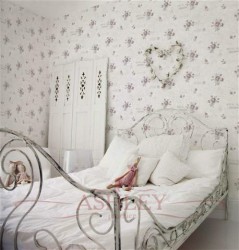 The range of paper wallpapers is so vast that you can find material of any desired color and with any pattern. Each of us has the right to organize the interior that he wants, but still, before buying wallpaper, remember that there is A few golden rules for choosing color and pattern:
The range of paper wallpapers is so vast that you can find material of any desired color and with any pattern. Each of us has the right to organize the interior that he wants, but still, before buying wallpaper, remember that there is A few golden rules for choosing color and pattern:
- for small rooms it is better to choose wallpapers of light and pastel shades that will visually push the boundaries of space. If the room, on the contrary, is too large, then you can use dark and saturated colors to make the room more comfortable;
- lack of lighting can be compensated wallpaper of warm shades: peach, yellow, pink, etc. If there is so much light, and the window in the room faces south, then cold shades of wallpaper will fit perfectly into the interior: blue, blue, green, purple, gray;
- large drawings are not for small rooms;
 wallpaper must blend in seamlessly with the interior: for example, minimalism will not tolerate a small flower wallpaper.
wallpaper must blend in seamlessly with the interior: for example, minimalism will not tolerate a small flower wallpaper.
It is also worth paying attention to the strength, moisture resistance and vapor permeability class of the wallpaper, because each room and individual circumstances put forward their own requirements for finishing materials.
It is also important to ensure that the packaging of the wallpaper is complete, and all purchased material belong to the same batch. In this case, there is a guarantee that the wallpaper in different rolls will have exactly the same shade and pattern. Pay attention to the certificates and the name of the manufacturer.
How to stick paper wallpapers?
The process of installing paper wallpapers is not so complicated, if you stick to certain rules.
Surface preparation
Wallpaper is glued to a smooth wall, cleaned of layers of the old finish. Depending on the type of previous coating, the following procedures are carried out:
 old wallpaper can be easily removed by pre-soaking them with soapy water. Some advise ironing them with a hot iron through a cloth soaked in a solution of soda or hydrogen peroxide. If thick wallpapers were pasted, then to speed up their impregnation with liquid, small cuts can be made over the entire surface;
old wallpaper can be easily removed by pre-soaking them with soapy water. Some advise ironing them with a hot iron through a cloth soaked in a solution of soda or hydrogen peroxide. If thick wallpapers were pasted, then to speed up their impregnation with liquid, small cuts can be made over the entire surface;- old paint can be removed with a special solvent. You can try to simply paint the oil paint with sandpaper, and the water-based paint - soak in soapy water and remove with a spatula;
- drywall or chipboard surface carefully putty to dirt all joints and indentations from nails and screws.
If there are noticeable defects in the form of cracks or holes on the wall, then they must be plaster. Then you can go to primingto strengthen the base and facilitate the further dismantling of wallpaper.
At this stage, you should also take care of all necessary tools:
- pencil and tape measure;
- scissors or knife;
- capacity for breeding wallpaper lei;
- brush and roller;
- sponge or piece of cloth.
Wallpaper and wall layout
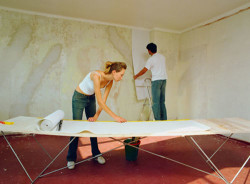 Before you open the rolls of wallpaper, you need to check whether they belong to the same batch, so that the pattern and color are completely the same. Now it is necessary to accurately measure the height of the walls, and on the seamy side of the wallpaper, designate the cut-off location, taking into account an increase of 6-10 cm in case of uneven walls. If the wallpaper has a pattern, it must be combined, and cut the canvas already with this in mind. Many manufacturers on the packages, by the way, indicate the allowance necessary for the combinations. Cut the canvas with a sharp knife or scissors. For convenience, on the reverse side you can make some notes for yourself (numbering, drawing direction, etc.).
Before you open the rolls of wallpaper, you need to check whether they belong to the same batch, so that the pattern and color are completely the same. Now it is necessary to accurately measure the height of the walls, and on the seamy side of the wallpaper, designate the cut-off location, taking into account an increase of 6-10 cm in case of uneven walls. If the wallpaper has a pattern, it must be combined, and cut the canvas already with this in mind. Many manufacturers on the packages, by the way, indicate the allowance necessary for the combinations. Cut the canvas with a sharp knife or scissors. For convenience, on the reverse side you can make some notes for yourself (numbering, drawing direction, etc.).
In order to glue the wallpaper as evenly as possible, you need to pay attention to the installation of the first canvas and the marking of the walls. So, we start sticking from the window. Preliminarily measuring the width of the wallpaper, lay it on the wall and draw a perfectly straight vertical line with a pencil. In the future, focusing on it, it will be much easier for you to achieve an ideal result. Before gluing, it is better to remove the housing of sockets and switches, as well as skirting boards.
Glue application
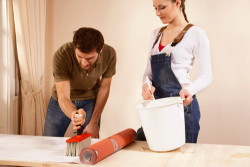 Glue bred according to the instructions. It must be applied to the wallpaper with an even thin layer, with particular attention to the edges. When glue is applied to the entire canvas, it is folded with the back side inwards for 5-7 minutes so that the material is well saturated with glue. It is important to keep all the strips folded the same amount of time in order to prevent the subsequent formation of bubbles or incorrect joints of the pattern. You can also glue the wall itself with glue.
Glue bred according to the instructions. It must be applied to the wallpaper with an even thin layer, with particular attention to the edges. When glue is applied to the entire canvas, it is folded with the back side inwards for 5-7 minutes so that the material is well saturated with glue. It is important to keep all the strips folded the same amount of time in order to prevent the subsequent formation of bubbles or incorrect joints of the pattern. You can also glue the wall itself with glue.
Wallpapering
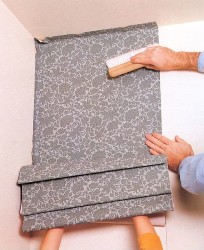 Now comes the most critical part of the work. Before this, you need to find out how the wallpaper is glued: butt or lap. In the second case, it is worth starting from the window so that the shadows do not interfere with you creating the most even, smooth and perfect surface.
Now comes the most critical part of the work. Before this, you need to find out how the wallpaper is glued: butt or lap. In the second case, it is worth starting from the window so that the shadows do not interfere with you creating the most even, smooth and perfect surface.
A section of wallpaper begins to be glued from above, gently pressing with a dry rag and smoothing the surface from the middle to the edges. The lower part must be kept folded and smoothed over during gluing. It is convenient if you are gluing together. In this case, the speed and efficiency of work will be an order of magnitude higher. Do not forget about allowances which should go a little on ceilings and a floor.When the wallpaper is completely dry, gently holding with a spatula, the excess is cut off with a knife.
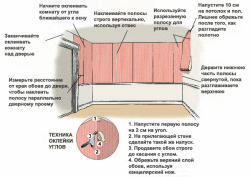 Joints between the paintings Smooth with a rubber roller so that they are minimally noticeable. Butt-gluing requires a lot of attention and special accuracy. If the wallpaper is glued with an overlap, then they should overlap each other by 2-3 mm.
Joints between the paintings Smooth with a rubber roller so that they are minimally noticeable. Butt-gluing requires a lot of attention and special accuracy. If the wallpaper is glued with an overlap, then they should overlap each other by 2-3 mm.
If the glue got on the front side of the wallpaper, it should be removed as soon as possible with a damp sponge. Do not rub too much or use an excessively damp sponge so as not to damage the surface.
Require special attention difficult places in the rooms:
 outer corner. In this case, it is necessary to measure the distance from the last glued strip to the outer corner, add 1-2 cm and cut off the canvas of just such a width. In the place where the wallpaper will be bent, small cuts can be made from above and below to facilitate the process. The next strip, on the other side of the outer corner, is necessarily overlapped by 1 cm overlap;
outer corner. In this case, it is necessary to measure the distance from the last glued strip to the outer corner, add 1-2 cm and cut off the canvas of just such a width. In the place where the wallpaper will be bent, small cuts can be made from above and below to facilitate the process. The next strip, on the other side of the outer corner, is necessarily overlapped by 1 cm overlap;- inside corner. The first strip should be so wide as to go to the other side of the corner with an overlap of 1 cm. On the other side, the wallpaper webs are glued clearly into the corner, without going to the adjacent side;
- sockets and switches. Before starting work on wallpapering, you must turn off the electricity. Wallpaper strips should completely cover places with switches and sockets. While the glue has not yet dried, it is necessary to cut holes in the required places. When everything is completely dry, you can install switches and sockets.
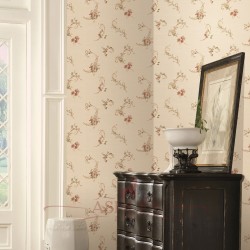 After completing all these procedures, you can install skirting boards, glue borders around windows, in the middle of a wall, near a ceiling or wall.
After completing all these procedures, you can install skirting boards, glue borders around windows, in the middle of a wall, near a ceiling or wall.
Paper wallpapers rarely paint, even despite the fact that there is a special type of wallpaper for painting. This is due to the fact that they are inferior in strength non-woven wallpaper and glass, which easily transfer layers of paint.
Finally
Paper wallpapers are a great affordable way to create the necessary interior in the bedroom, child or living room. This is a natural, eco-friendly finish that impresses with the range. Paper wallpapers will fit perfectly into different interior styles: from classical to minimalism. It remains only to choose them correctly and stick accordingly. Both that, and another to make it is simple, if to be attentive to trifles and to observe several rules.

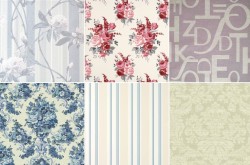

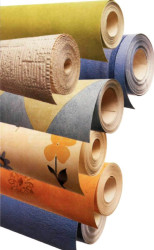
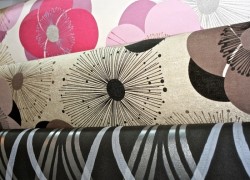
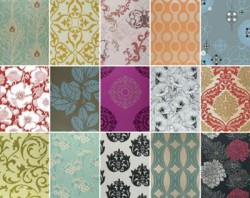
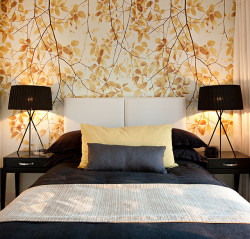
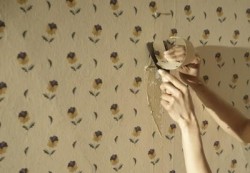
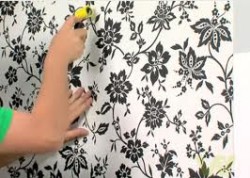



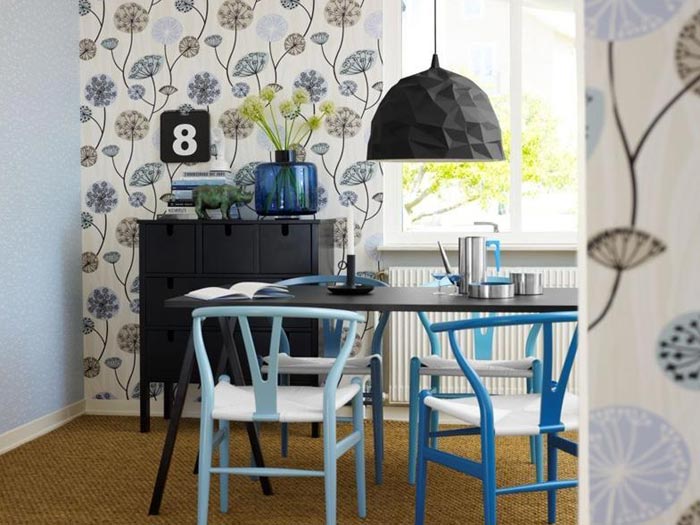
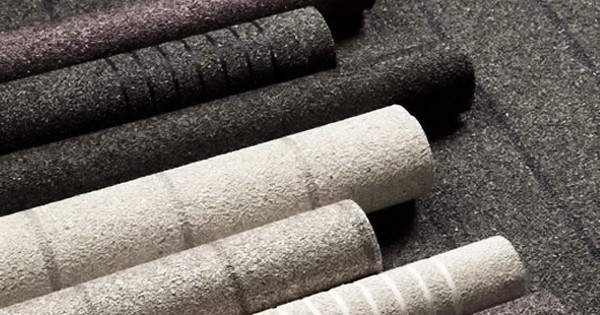
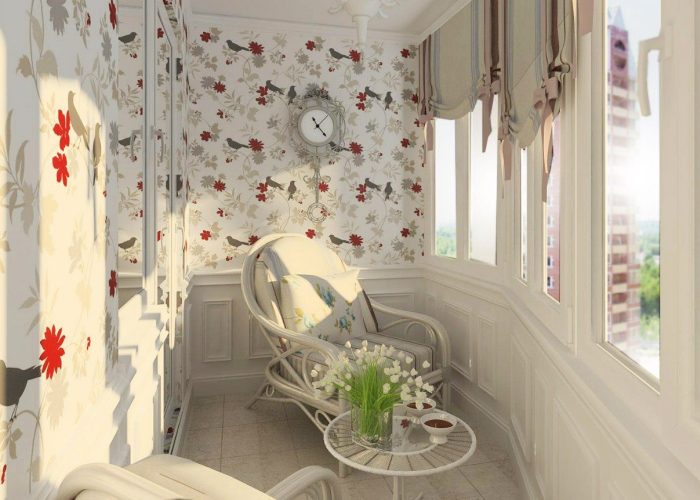



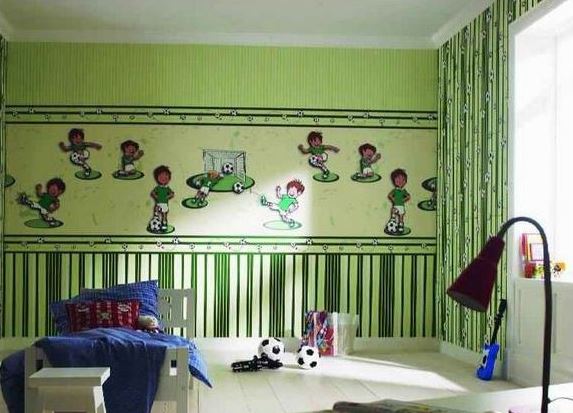
It can help a lot, especially those who are at the beginning of the repair